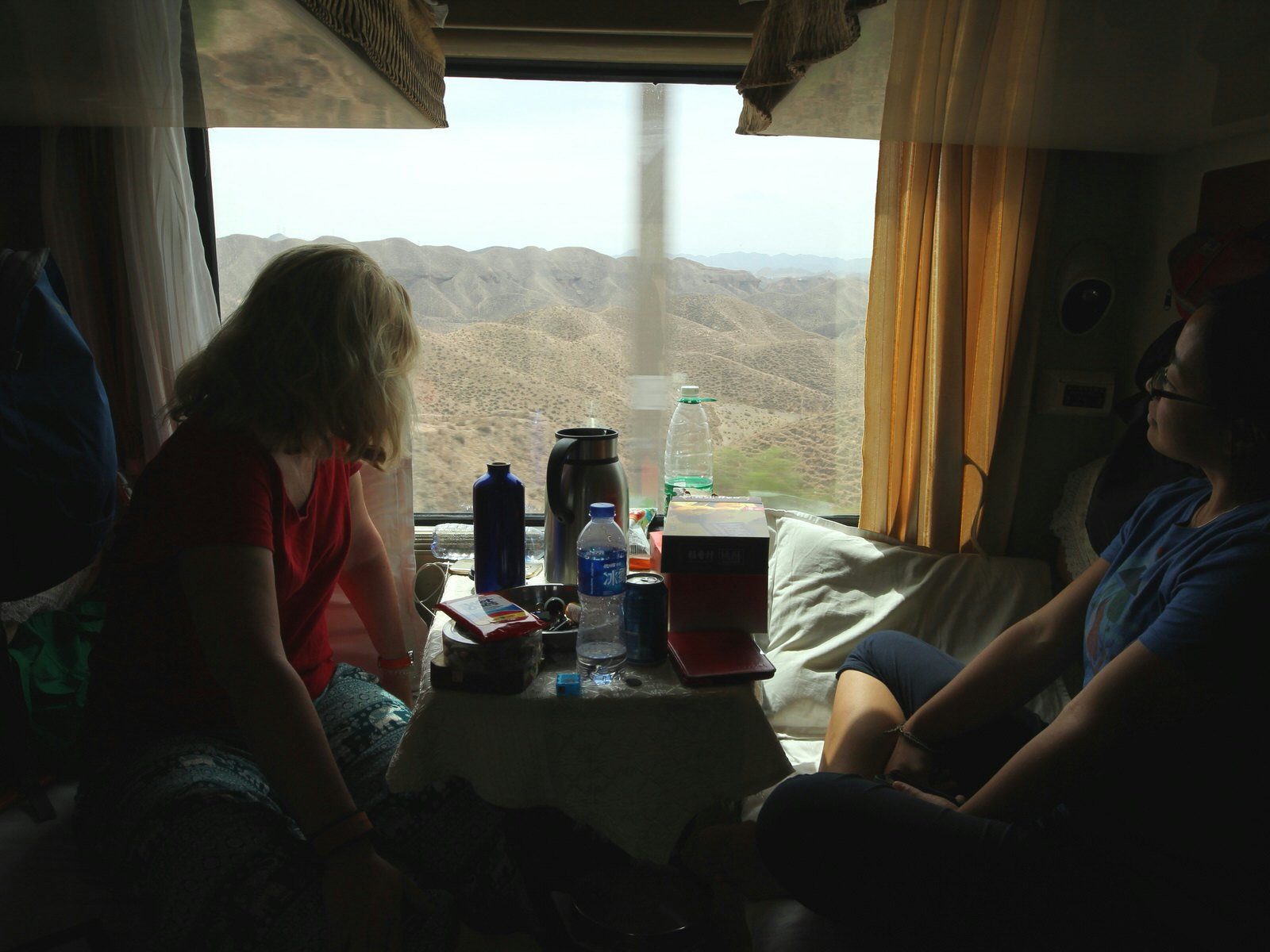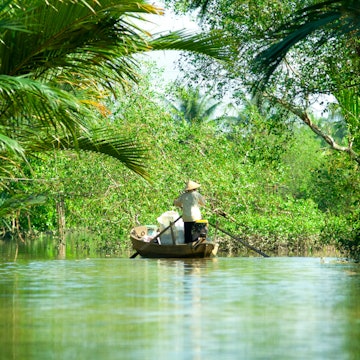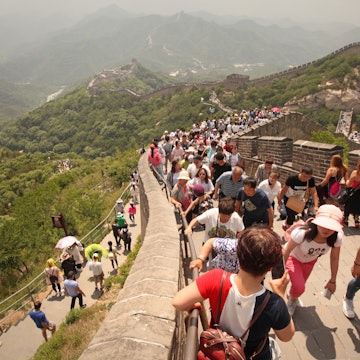

The Qinghai-Tibet Railway passes some of the most stunning high-mountains in the world © View Stock / Getty
The lofty snowcapped Kunlun Mountains are veiled in a wispy mist as the train climbs up a steep mountain pass, trudging toward Lhasa. Through the window, great expanses of the Qinghai-Tibet Plateau roll into view: grasslands dotted with black yaks and prayer flags fluttering from gold-topped temples. This is definitely the 'roof of the world'.
For centuries, Tibet was cut off from the outside world by its remote location, extreme climate and geographic environment. This far-flung region thwarted all but the boldest travellers and explorers — that is, until the construction of the Qinghai-Tibet Railway in 2006, which connected Tibet to the rest of China.

Those seeking the romance of Tibet will find the Qinghai-Tibet Railway an evocative journey that transports you to a different world, one far from the neon signs and skyscrapers of urban China. The train trundles its way through the back country and high mountains of remote Qinghai and into Tibet, snaking past glaciers, peaks, shimmering salt lakes and charming villages. Here's what to expect along the way.
An engineering marvel
The Qinghai-Tibet Railway holds the record for the world’s highest train route, reaching altitudes over 5000m. The railway line, which cost US$4.2 billion to build, is an extraordinary feat of modern engineering. Sometimes hailed as the 'sky road', the railway traverses a region known for earthquakes, low temperatures and low atmospheric pressure.

As 960km of the line sits at 4000m, the designers and engineers had to tackle three main challenges during construction: the fragile ecosystem, the lack of oxygen and permafrost.
To provide proper aid for the construction workers, the government built dozens of medical facilities and oxygen-making stations along the way to alleviate the effects of altitude sickness. The route was also carefully chosen to avoid destruction of vegetation and the natural habitations of wild animals, and they tried to ensure stability in permafrost regions by installing gravel embankments.
The train route
Extending 1956km across the Qinghai-Tibet Plateau, the rail journey officially starts from Xining, capital of Qinghai province, and ends in Lhasa, capital of Tibet. From start to end, the trip takes only one day (20 hours 55 minutes to be exact), and there are trains plying the same route every day. It is possible to make stops along the journey, but this is not a spontaneous hop-on/hop-off affair. You’ll need to decide your route in advance and buy tickets for each leg.

The journey is a spectacular tour of the elevated highlights of Qinghai and northern Tibet: the boundless Qiangtang Prairie, the desolate, golden Gobi Desert and the wildlife-rich Kekexili Nature Reserve (where you can spot Tibetan antelope and wild yak).
There are plenty of dramatic moments as the train zips past spearmint-blue Qinghai Lake, trundles alongside the sparkling white Qarhan Salt Bridge, and skirt the edges of the legendary Namtso Lake. But, without a doubt, the highlight is seeing the Tanggula Mountains covered with snow all year round.

Passing the Tanggula Glacier, you really get a sense of the altitude at which you're moving. At a soaring 5068m above sea level, Tanggula is home to the world’s highest railway station. It will literally take your breathe away — the oxygen levels drop by a drastic 60% at this point.
Onboard experience
The Qinghai-Tibet trains are unique in every sense of the word, even when it comes to design. All the trains to Tibet take into account the conditions faced — from the high elevation and lack of oxygen to the low temperatures and harsh climate.

To protect passengers from high-altitude sickness, trains have an oxygen supply system that increases the oxygen in the cabin as the train ascends and cabins have private oxygen-dispensing outlets. The temperature in the train is regulated and pressurised and the windows are glazed with a UV coating to protect against the powerful high-altitude rays.
Like most trains in China, Qinghai-Tibet trains are relatively clean, comfortable and have a restaurant carriage, toilets (squat and seater), washing facilities and hot water dispensers. As the majority of travellers on the Qinghai-Tibet Railway are Chinese, you'll find the train attendants often don’t speak English.

There are three different classes of seats:
Hard seat: Cushioned seats with five in a row, can be overcrowded and are the cheapest, but least comfortable, for long-distance journeys.
Hard sleeper: Six beds in half-opened compartments, with luggage storage above the window. Mattresses are thin and liners are provided.
Soft sleeper: Four thick-cushioned beds in private, lockable, spacious compartments.
What to pack
It’s best to pack light and carry a backpack to keep your hands free to flash your ticket and passport. If you opt for a suitcase, make sure to bring a compact one as train corridors are narrow.
As the inside temperatures are regulated to a pleasantly warm degree, lightweight, loose-fitting clothes are sensible. Slippers are provided for free in the soft sleeper berths.

While travelling by train lowers the risk of altitude sickness (as you’re easing into high altitude), many passengers still suffer. Pack medication such as Diamox (Acetazolamide), which can help alleviate symptoms.
You won’t need to pack much food as the train has a food cart and restaurant carriage, but you can carry on snacks, too. Instant noodles, sachets of oatmeal, tea bags and soup can be made using on-board hot water dispensers.
Make it happen
Tickets can be very hard to get in July and August; it's best to book in advance online at chinatibettrain.com or through a travel agent. Be aware that travellers to Tibet also need to secure a variety of permits in advance.
While the official start of the Qinghai-Tibet Railway is Xining, there are direct trains from a handful major cities to Lhasa, including Beijing (40 hours), Chengdu (43 hours) and Shanghai (47 hours).

Prices vary depending on seat class and date of travel, but a single Xining–Lhasa soft-sleeper ticket averages around ¥780 (US$125), while a hard-sleeper goes for around ¥495 Yuan (US$72).
To board, keep the printed train ticket at hand. Most tour operators or booking agents will deliver the ticket to you at your hotel in China upon arrival. Make sure to arrange for collection at least a day before your train departure date.













